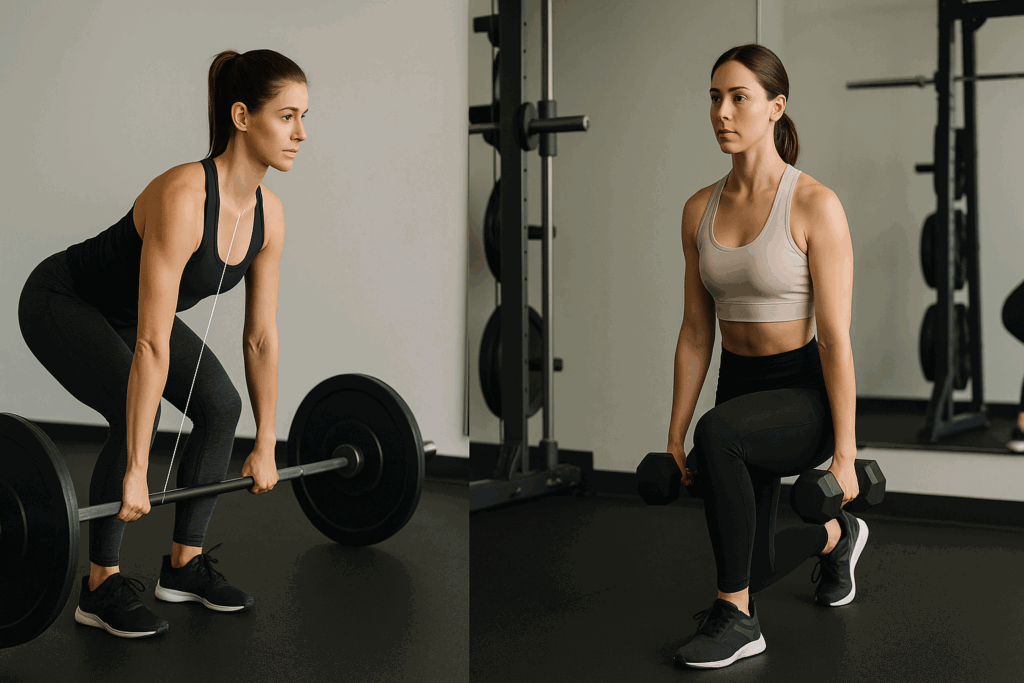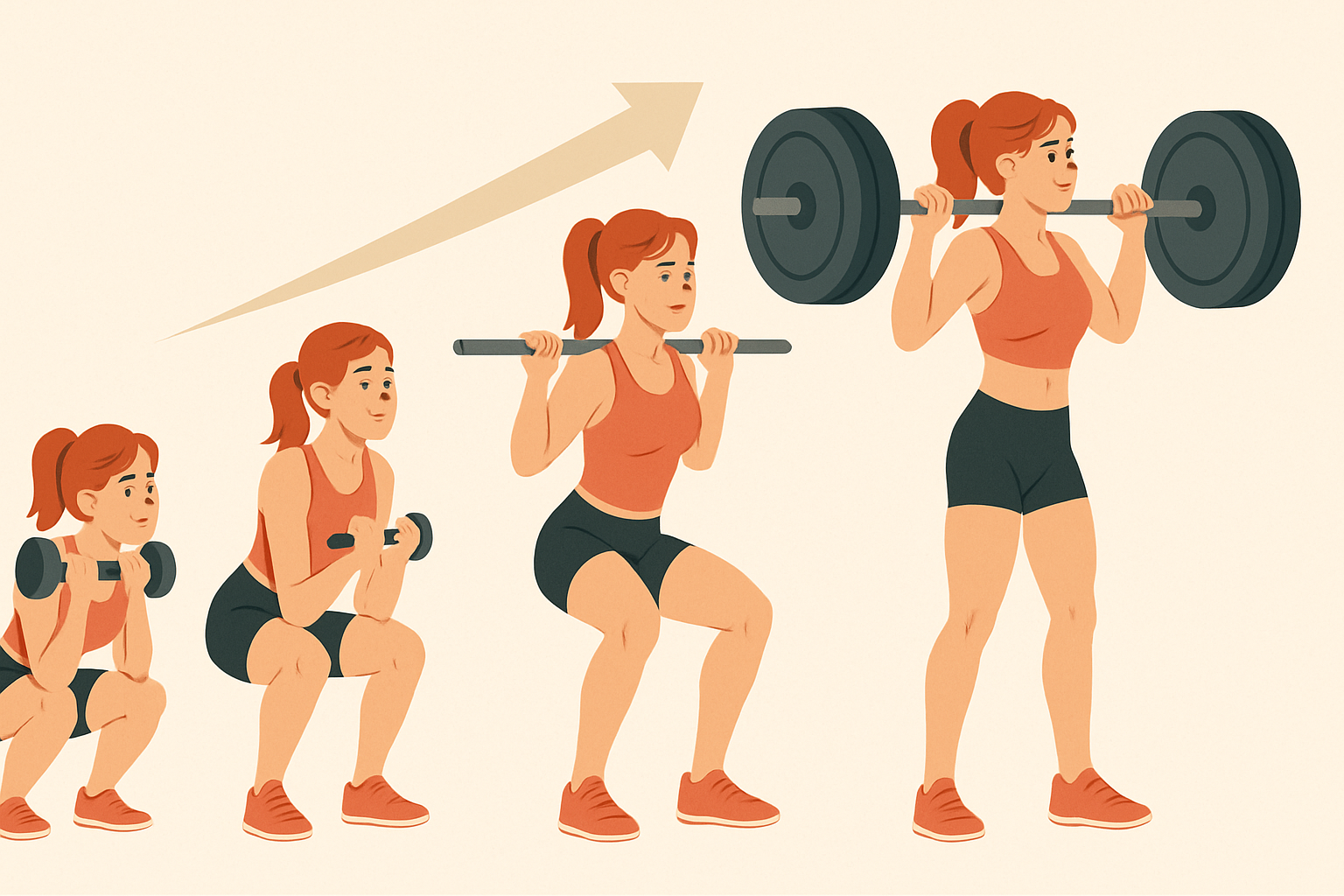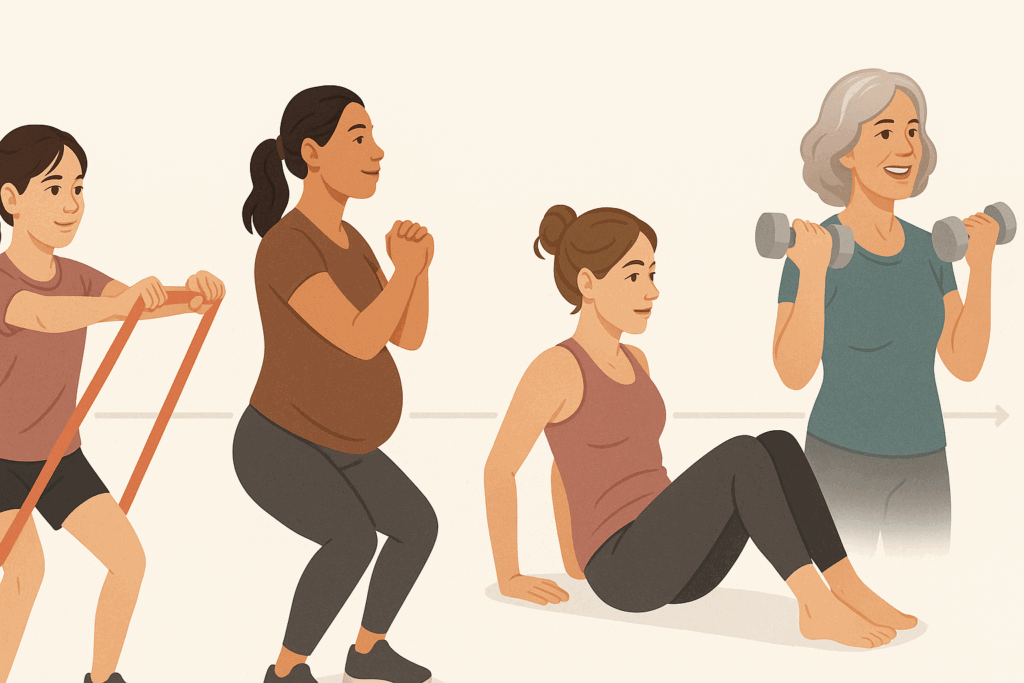Introduction: Redefining Strength and Fitness for Women
In today’s evolving fitness culture, more women are recognizing the transformative benefits of structured resistance training. For decades, outdated myths and misconceptions painted weightlifting as an activity reserved for men or competitive athletes, often suggesting that women should avoid heavy weights for fear of becoming “too bulky.” However, scientific evidence and the lived experience of countless women have now firmly debunked these stereotypes. A thoughtfully designed weight training program for women does far more than sculpt a lean, toned physique—it enhances metabolic function, builds bone density, improves joint health, and cultivates empowering mental resilience.
At the intersection of strength and science lies a shift in how we define femininity and fitness. Today, more than ever, women are embracing the barbell, dumbbell, and cable machine not just to change their bodies but to redefine what their bodies can do. A successful weight training program for women is tailored to support hormonal differences, anatomical considerations, and personal fitness goals. It integrates the principles of progressive overload, recovery, and periodization into a comprehensive strategy that fits seamlessly into real life. From gym workouts for women that suit beginners to advanced female weight training programs designed for performance, this guide will explore every aspect of how women can build muscle, increase strength, and thrive.
You may also like: The Ultimate Hypertrophy Workout Program for Building Strength and Size

Understanding the Foundations of a Female Weight Training Program
Before diving into exercise selection or program design, it’s critical to understand the unique physiological and anatomical considerations that make female strength training distinct. Women generally have lower testosterone levels than men, which affects the rate and magnitude of muscle hypertrophy. However, this does not hinder the effectiveness of weight training—it simply shapes how muscle development occurs. Women typically benefit from higher volume training with slightly more repetitions per set, and they often recover more quickly between sets compared to men.
Understanding these foundational elements helps structure an effective strength training program for women. It also encourages a shift away from generic gym routines to more personalized gym plans for women. This approach not only enhances results but also reduces the risk of injury. Functional strength is another cornerstone of female weight training. Movements like squats, lunges, deadlifts, and presses simulate real-life activities and improve daily performance. Core strength and pelvic stability are equally essential, especially for postpartum women or those planning to become pregnant.
Furthermore, incorporating compound movements in a workout routine for women yields greater strength adaptations compared to isolated movements alone. These exercises activate multiple muscle groups, stimulate a more substantial hormonal response, and foster coordination. A well-rounded female gym routine balances these principles with flexibility, cardiovascular conditioning, and mobility work, allowing women to progress sustainably.

Benefits of Following a Weight Training Program for Women
The benefits of adhering to a consistent weight training program for women extend well beyond aesthetics. Strength training significantly improves metabolic rate, which assists in fat loss and weight management. As lean muscle mass increases, the body becomes more efficient at burning calories, even at rest. This metabolic boost is particularly beneficial for women navigating perimenopause or menopause, when hormonal shifts often lead to weight gain.
Additionally, strength training plays a vital role in improving insulin sensitivity, reducing the risk of type 2 diabetes, and enhancing cardiovascular health. Resistance training stimulates the heart and vascular system in ways that complement aerobic conditioning. Furthermore, lifting weights contributes to long-term bone health by increasing bone mineral density—a critical factor in preventing osteoporosis.
Mental health also benefits significantly. Weightlifting has been shown to reduce symptoms of depression and anxiety, boost confidence, and foster a positive body image. For many women, the psychological empowerment gained from setting and surpassing strength goals translates into other areas of life. By engaging in a structured gym workout plan for beginners female athletes and seasoned lifters alike can experience profound improvements in overall well-being.

Designing the Best Workout Plan for Female Strength and Muscle Gains
Creating the best workout plan for female strength training requires a balance between science and individualization. The ideal program considers a woman’s training history, fitness goals, lifestyle demands, and recovery capacity. For beginners, a full-body split performed three times per week is often the most effective starting point. This frequency allows for consistent stimulus without overwhelming the body, supporting gradual progress in technique and confidence.
Intermediate and advanced lifters may transition into an upper/lower body split or push/pull/legs routine, training four to six times per week. These structures accommodate higher training volume and intensity, making them suitable for a female weight lifting schedule that emphasizes progressive overload. Incorporating both free weights and machines adds variety and challenges the muscles in different ways.
Periodization is another critical component of a successful strength training program for women. This involves cycling training intensity, volume, and exercise selection over time to prevent plateaus and reduce the risk of overtraining. For instance, alternating hypertrophy-focused mesocycles (8–12 reps) with strength-focused blocks (3–6 reps) promotes well-rounded development.
Rest and recovery also deserve attention. While enthusiasm is essential, rest days are when the body rebuilds and grows stronger. Including active recovery days with light cardio or mobility work can enhance performance without compromising recovery. A female gym workout schedule that honors this balance fosters consistency and long-term gains.

Progressive Overload: The Key to a Successful Female Weight Training Program
One of the most fundamental principles in strength training is progressive overload—gradually increasing the demands placed on the muscles. Without this stimulus, the body has no reason to adapt or grow stronger. Implementing progressive overload can be done by increasing weight, adding more repetitions, enhancing time under tension, or decreasing rest intervals.
For women following a gym plan for women that prioritizes strength and hypertrophy, tracking progress is crucial. Maintaining a training log helps identify trends and plateaus, allowing for timely program adjustments. For example, if deadlifts have stalled, introducing variations like deficit deadlifts or Romanian deadlifts can break through plateaus.
It’s also important to recognize that progression is not always linear. Factors like sleep, nutrition, stress, and the menstrual cycle can influence training performance. Women who tailor their strength training routine for women to accommodate these variables often experience more consistent progress. Deload weeks—intentional reductions in training intensity—can also aid in long-term recovery and motivation.
For those pursuing a beginner gym workout female plan, even small improvements such as mastering proper squat form or increasing push-up repetitions represent meaningful progress. These victories lay the groundwork for future success and reinforce a positive relationship with training.
Balancing Cardio and Strength in a Female Gym Workout Schedule
While strength training forms the foundation of a weight lifting program for women, cardiovascular exercise also has a valuable place in a comprehensive fitness strategy. Cardio enhances heart health, supports fat loss, and contributes to overall endurance. The key lies in balancing intensity and volume to prevent interference with strength gains.
Low- to moderate-intensity cardio, such as brisk walking or cycling, pairs well with resistance training and aids recovery. High-intensity interval training (HIIT), performed once or twice per week, can improve conditioning without excessive time commitment. However, it’s essential not to overdo cardio, particularly when muscle gain is the primary objective.
For women crafting a gym routine for women that integrates both modalities, placing cardio sessions on separate days or after weight training can optimize results. Nutrition also plays a pivotal role in managing energy demands. Fueling workouts with adequate carbohydrates and protein ensures peak performance and recovery.
A holistic female gym plan also encourages mindfulness and listening to the body’s signals. Rest, hydration, and sleep are equally important. Striking the right balance between strength and cardio helps women achieve their goals without compromising muscle gains or well-being.

Creating a Sustainable Gym Routine for Women of All Experience Levels
Consistency is the cornerstone of any effective training program. Developing a sustainable gym routine for women involves more than just selecting the right exercises. It requires a thoughtful approach to scheduling, motivation, and long-term goal setting. The most successful plans are those that integrate seamlessly into daily life and adapt as needs evolve.
Beginner gym workout female programs should prioritize simplicity and repeatability. A full-body routine performed on non-consecutive days allows for sufficient recovery and builds confidence. As women gain experience, they can explore more complex structures like upper/lower splits or even specialized lifting program for women tailored to sport or aesthetic goals.
Lifestyle factors must also be considered. Women juggling work, family, or school responsibilities need programs that offer flexibility without sacrificing effectiveness. Home-based workouts, short gym sessions, and hybrid models can all serve as viable options. The key is to remove barriers and promote consistency.
Tracking progress through journals or apps can enhance accountability and provide a sense of accomplishment. Visualizing progress through strength benchmarks, clothing fit, or energy levels reinforces commitment. Ultimately, a sustainable gym workout plan for beginners female or advanced must be one that aligns with personal values and lifestyle realities.

Nutrition and Recovery in a Female Weight Lifting Schedule
No weight training program for women is complete without attention to nutrition and recovery. These elements are the unsung heroes of muscle growth, energy optimization, and hormonal balance. Protein intake is particularly important, as it supplies the amino acids necessary for muscle repair and hypertrophy. Women engaged in regular resistance training should aim for 1.6 to 2.2 grams of protein per kilogram of body weight.
Carbohydrates are the body’s primary fuel source during intense workouts. They replenish glycogen stores and support high-performance output. Including complex carbs like whole grains, legumes, and starchy vegetables ensures a steady energy supply. Fats also play a role in hormonal health, supporting estrogen production and aiding in nutrient absorption.
Recovery extends beyond sleep, though sleep remains a critical factor in muscle repair and cognitive function. Practices like foam rolling, stretching, and contrast therapy can alleviate muscle soreness and improve circulation. Listening to the body’s feedback is essential. Fatigue, irritability, or declining performance may signal the need for more rest or nutritional adjustment.
A well-balanced strength training routine for women acknowledges that gains don’t just happen in the gym—they’re built during the hours of nourishment and restoration that follow. Incorporating strategic meal planning, rest, and stress management creates an environment in which the body can flourish.

How to Modify a Female Gym Plan Through Different Life Stages
Women’s fitness journeys often span diverse life stages, each presenting unique physiological demands and opportunities. Adolescence, preconception, pregnancy, postpartum, and menopause all influence training capacity and priorities. A flexible workout routine at gym woman plan should evolve to reflect these changes.
During adolescence, the focus is often on developing proper movement patterns, coordination, and confidence. Resistance training during this phase supports bone development and fosters healthy habits. In the preconception and pregnancy periods, strength training can alleviate musculoskeletal discomfort, improve circulation, and prepare the body for childbirth.
Postpartum training requires sensitivity to healing timelines, pelvic floor health, and sleep deprivation. A phased return to lifting, starting with bodyweight exercises and core rehabilitation, lays a safe foundation. During menopause, hormonal shifts can affect muscle mass and recovery. Resistance training becomes even more crucial for maintaining bone density and metabolic function.
Adapting a gym schedule for women across these stages ensures that fitness remains a source of empowerment and resilience. Consulting with trained professionals, including physical therapists and prenatal-certified trainers, can help women navigate these transitions safely and confidently.
Frequently Asked Questions: A Deep Dive into the Weight Training Program for Women
What are some psychological benefits of a weight training program for women that are often overlooked?
Beyond the well-known physical advantages, one of the most impactful benefits of a weight training program for women is the mental clarity and emotional resilience it fosters. Regular resistance training has been shown to improve cognitive function, enhance focus, and even strengthen neural plasticity, which becomes particularly relevant as women age. Engaging in structured workouts also creates a positive feedback loop, reinforcing a sense of discipline, goal orientation, and self-efficacy. Women who consistently adhere to a weight lifting program for women often report heightened self-confidence, a stronger sense of personal identity, and reduced reliance on external validation. This transformation is especially visible among women who initially feel intimidated in gym spaces—what begins as a physical goal soon becomes a journey of emotional empowerment.
How can a woman adapt her gym routine for hormonal fluctuations throughout her menstrual cycle?
Hormonal fluctuations significantly influence energy levels, recovery, and muscle performance, yet they are rarely addressed in generic workout programs for women. During the follicular phase (the first half of the cycle), estrogen levels rise, leading to increased strength and faster recovery, making this an ideal time to focus on heavier lifts or more intense phases of a strength training routine for women. In contrast, the luteal phase may bring about fatigue or decreased coordination due to progesterone dominance, suggesting a shift toward lighter intensity, mobility work, or technique refinement. Tracking the menstrual cycle with apps or journals can provide valuable insights, helping to shape a more intuitive female gym workout schedule. This approach ensures that a female weight lifting schedule is biologically aligned, leading to more consistent results and improved adherence.
Why should women include powerlifting or Olympic lifts in their strength training program for women?
Though often perceived as advanced or intimidating, compound lifts like deadlifts, squats, cleans, and snatches can significantly enhance total-body strength and functional fitness. Including these in a strength program for women promotes neuromuscular efficiency, builds core stability, and cultivates explosive power, which translates into better performance in both athletic and everyday activities. These lifts also support hormonal responses favorable to muscle development and fat metabolism. While they require technical proficiency, starting with scaled variations under the guidance of a certified coach can safely introduce them into a female weight training program. Over time, these lifts offer a satisfying progression path and help women break through strength plateaus that may arise in more traditional gym workouts for women.
What role does community support play in maintaining a long-term gym routine for women?
Social reinforcement plays a pivotal role in sustaining long-term fitness habits, especially in structured gym routines for women. Participating in small group training sessions, fitness classes, or online strength training communities can provide accountability, encouragement, and camaraderie. Women who feel seen and supported in their journey are more likely to overcome challenges like plateaus, fatigue, or self-doubt. Sharing experiences with others also fosters a sense of belonging and validates the unique struggles that may arise, whether related to body image, motivation, or time management. For a beginner gym workout female plan, joining a supportive network often bridges the gap between initial enthusiasm and long-term commitment.
How can a weight training program for women be adjusted during perimenopause and menopause?
During perimenopause and menopause, declining estrogen and progesterone levels can affect bone density, muscle mass, and fat distribution, making a weight training program for women even more essential. This stage requires a shift toward maintaining muscle integrity, joint health, and metabolic resilience. Increasing the focus on strength-specific rep ranges (3–6 reps), compound movements, and rest intervals can help counteract muscle loss and fatigue. Nutrition becomes more critical, with an emphasis on calcium, vitamin D, and adequate protein to support recovery and hormonal balance. A customized female gym plan that prioritizes joint-friendly lifts and flexibility training can empower women to navigate these transitions with strength and confidence.
What’s the best way to approach progressive overload in a female gym plan without risking burnout?
Progressive overload isn’t just about lifting heavier weights—it also includes increasing reps, reducing rest times, enhancing time under tension, or improving movement quality. For women following a structured gym schedule for women, adopting a wave-loading approach—where intensity ebbs and flows across training cycles—can help avoid central nervous system fatigue. Incorporating deload weeks every four to six weeks provides physiological and psychological recovery. Mindful variation in a weight lifting plan for women, such as alternating between hypertrophy and strength blocks, can keep muscles challenged without risking stagnation or injury. Listening to cues like lingering fatigue, disrupted sleep, or poor performance ensures that progress doesn’t come at the cost of well-being.
How can a woman design a time-efficient exercise plan for women with a busy schedule?
Many women assume that they need hours in the gym to see results, but a time-efficient exercise plan for women can deliver impressive outcomes in as little as 30–45 minutes per session. Prioritizing compound lifts like squats, rows, and presses allows maximal muscle engagement in minimal time. Supersets and circuit formats can further streamline workouts while maintaining cardiovascular benefits. For a busy professional or caregiver, a female gym routine structured around three to four efficient sessions per week is both realistic and effective. Pairing a thoughtful gym plan for women with weekend mobility sessions or home-based flexibility work helps maintain consistency without overwhelming daily schedules.
What are the most overlooked mistakes in a beginner gym workout female plan?
For those new to strength training, the most common pitfalls include over-reliance on machines, neglecting proper form, and failing to track progress. Machines can be helpful initially, but overusing them limits functional movement development. Similarly, skipping movement assessments or mobility work can lead to imbalances and long-term injury risk. Another overlooked mistake is inconsistency—many beginners don’t stick with a workout routine at gym woman long enough to witness results, causing them to prematurely abandon the process. Emphasizing education, scheduling consistency, and progressive learning ensures a smoother entry into a sustainable female weight training program.
Why is recovery often undervalued in a strength training plan for women?
Despite its crucial role, recovery is often underestimated in a strength training plan for women. Adequate sleep, nutrition, and stress management all contribute to muscle repair, hormonal regulation, and performance. Inadequate recovery can compromise progress, increase injury risk, and disrupt motivation. Techniques like active recovery, myofascial release, and contrast therapy are underused but highly beneficial in a female gym workout schedule. Embracing recovery as part of the training journey—not a pause from it—helps sustain momentum and optimize long-term results, especially within a high-volume lifting program for women.
How can strength training help women break free from restrictive fitness ideologies?
Many women have been conditioned to equate fitness with shrinking their bodies, which can foster unhealthy relationships with exercise and food. A strength training program for women reframes fitness as a tool for empowerment, functionality, and longevity rather than just aesthetics. When women follow structured workout programs for women that prioritize capability, they often begin to appreciate what their bodies can do rather than how they look. This mindset shift cultivates intrinsic motivation and long-term adherence, breaking the cycle of yo-yo dieting or over-exercising. A woman lifting weights routine serves not only as physical training but also as a declaration of autonomy in a fitness culture long dominated by unrealistic standards.
Conclusion: Embracing Long-Term Success with a Proven Weight Training Program for Women
Embarking on a weight training program for women is more than a physical endeavor—it’s a commitment to lifelong health, strength, and empowerment. By aligning exercise plans with individual goals, respecting the body’s needs, and embracing progressive overload, women can achieve remarkable results in strength, muscle development, and overall vitality. The best workout plan for female fitness is not a one-size-fits-all template but a personalized journey grounded in evidence-based principles and a deep respect for the female body’s resilience.
Whether you’re a female at gym for the first time or returning after a hiatus, the path forward is built on consistency, education, and support. From beginner gym workout female routines to advanced lifting program for women strategies, this guide provides the knowledge and tools to cultivate strength from the inside out. Let this be your roadmap to a healthier, stronger future—one lift, one rep, and one powerful transformation at a time.
Further Reading:
12 Week Weight Training Program for Women





